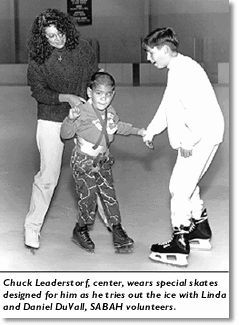
Research center helps bring assistive devices to market
By LOIS BAKERNews Services Editor

Billy Decker, born with Down's Syndrome, will be able to ice skate wearing skates designed especially to accommodate his feet.
Terra Prescott will be more independent and able to cook for herself using a new product called a kettle holder, designed for persons with spasticity or limited grip strength.
Persons with hearing impairments will be able to purchase a flashing timer small enough to fit in the palm of the hand, usable in the classroom, gym, pool and at home.
These and other helpful assistive devices were made possible through the UB Rehabilitation Engineering Research Center for Technology Evaluation and Transfer, the only organization in existence devoted exclusively to bringing assistive devices that are needed, but not available, into the marketplace.
The research center was established in 1993 with a grant from the National Institute on Disabilities and Rehabilitation Research, an arm of the U.S. Department of Education. One of its charges was to find inventors who had designed promising, but untested devices, and to move them from the workshop to store shelves.
"Really helpful products often never reach consumers with disabilities because many designers and inventors don't have resources to develop their ideas and make them marketable, and don't know how to link up with a manufacturer," said Joseph Lane, director of the research center. "On the other hand, manufacturers often lack knowledge about consumer needs and product requirements for persons with disabilities. Our center provides the knowledge and resources to fill those gaps."
 This is how the process works:
This is how the process works:
Research center technical experts have worked with more than 1,500 inventors to date and have evaluated nearly 200 devices, 33 of which were deemed useful and marketable. Twenty-two of the products are in various phases of commercialization, with the first devices due to be available this fall.
Inventors such as Joseph French of Joppa, Md., creator of the Echometer, a device used to assist people with communication disorders, pay an initial fee of $50.
"Because of them," said French of the research center and its partners, "this is the first time that any of my designs have had a chance in the marketplace."
Other products developed, evaluated or marketed through the research center include:
To Lane, the center's contributions are tangible and pragmatic. "Persons with disabilities have more devices to help them lead productive, independent lives; fewer dollars have to be spent on community and home care, and companies have more useful products to sell," he said. "Everybody wins."